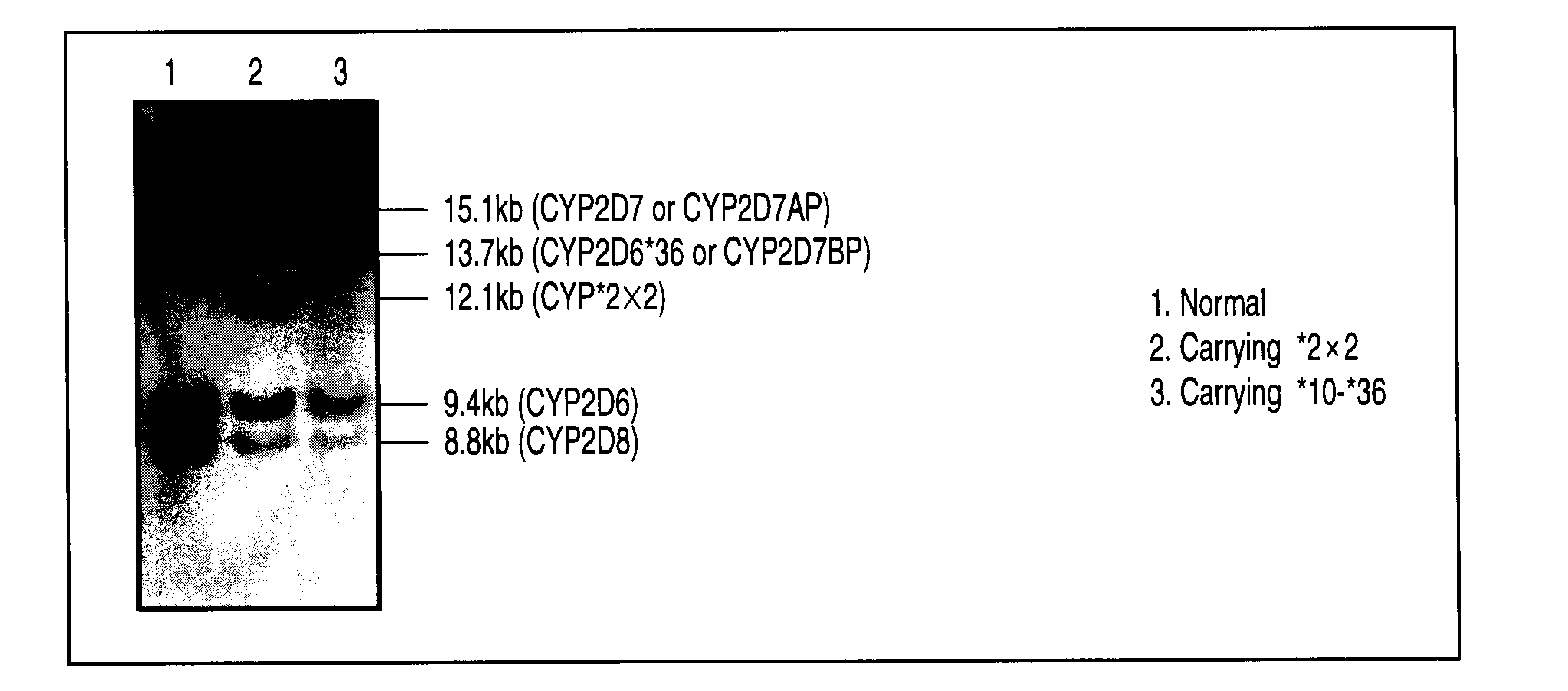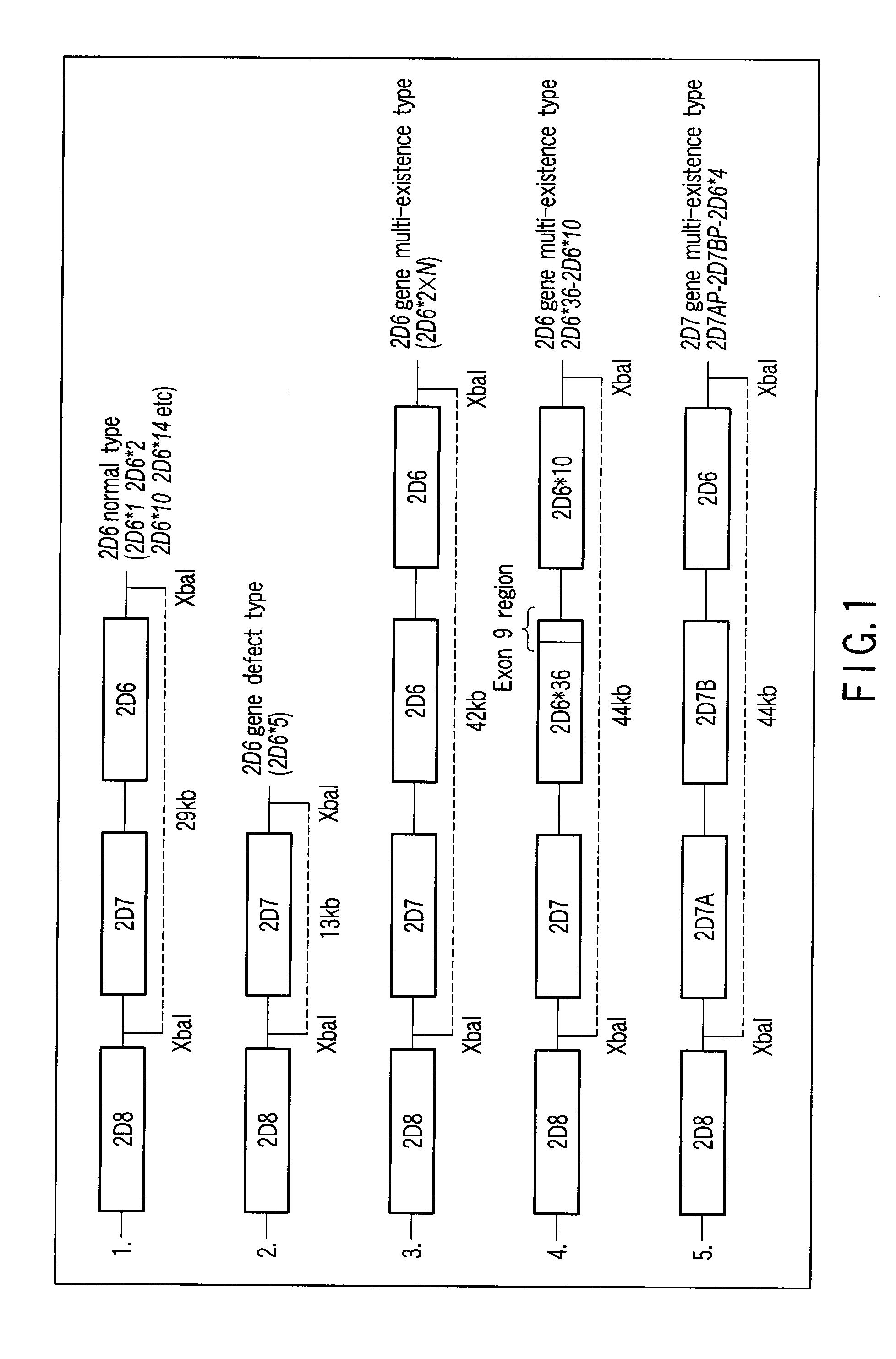Method of detecting human cytochrome p450 (CYP) 2d6 gene mutation
a human cytochrome p450 and gene multi-existence technology, applied in the field of detecting the defect and multi-existence of the human cytochrome p450 (cyp) 2d6 gene, can solve the problems of inability to distinguish the lack of amplification, troublesome operation, and difficult detection of the cyp2d6 gene defect type (cyp2d6*5), and achieve the effect of accurate detection of the cyp2d6 gene d
- Summary
- Abstract
- Description
- Claims
- Application Information
AI Technical Summary
Benefits of technology
Problems solved by technology
Method used
Image
Examples
embodiments
[0071]Hereinafter, the determination of the amplified products by using a nucleic acid-immobilized substrate is described. The nucleic acid probe contains a sequence complementary to the detection sequence, as described above. The nucleic acid probe is made of, but is not limited to, DNA, RNA, PNA, LNA, a nucleic acid having a methyl phosphonate skeleton, and other artificial nucleic acids. For immobilization on a substrate, the terminus of the nucleic acid probe may be modified with a reactive functional group such as an amino group, a carboxyl group, a hydroxyl group, a thiol group or a sulfone group. A spacer may be introduced into between the functional group and the nucleotide. For example, a spacer consisting of an alkane or ethylene glycol skeleton may be used.
[0072]
[0073]A schematic diagram of the nucleic acid probe-immobilized substrate in one embodiment is shown in FIG. 5. The nucleic acid probe is immobilized in an immobilization region 2 on a substrate 1. The substrate 1...
example
Type Analysis of 19 Samples of Japanese Genome
[0124]According to the method of the present invention, a CYP2D6 gene defect and multi-existence in 19 samples of Japanese genome was determined by the LAMP method.
[0125]
[0126]The positions of 5 kinds of primers used in the LAMP method are shown in Table 18. The sequence of each primer is shown below:
F3 primer:5′-AGCCAGGCTCACTGACG-3′B3 primer:5′-CTAGCGGGGCACAGC-3′FIP primer:5′-GGTGAAGAAGAGGAAGAGC(F1c)-ACAGGCCGCCGTG(F2)-3′BIP primer:5′-TCTCGGTGCCCAC(B1c)-AAAGCTCATAGGGGGATGG(B2)-3′FLc primer:5′-ATGCGGGCCAGGGG-3′
[0127]60 ng of genome was added to 25 μl reaction solution and reacted at 63° C. for 1 hour. Table 4 shows the composition of the LAMP reaction solution.
TABLE 4PrimerSequenceF3AGCCAGGCTCACTGACGB3CTAGCGGGGCACAGCFIPGGTGAAGAAGAGGAAGAGC(F1c)-ACAGGCCGCCGTG(F2)BIPTCTCGGTGCCCAC(B1C)AAAGCTCATAGGGGGATGG(B2)FLcATGCGGGCCAGGGGBst DNA Polymerase2μL2 × Buffer12.5μLTris·HC1 pH8.0 40 mMKC1 20 mMMgSO4 16 mM(NH4)2SO4 20 mMTween20 0.2%Betaine 1.6 MdNT...
PUM
 Login to View More
Login to View More Abstract
Description
Claims
Application Information
 Login to View More
Login to View More - Generate Ideas
- Intellectual Property
- Life Sciences
- Materials
- Tech Scout
- Unparalleled Data Quality
- Higher Quality Content
- 60% Fewer Hallucinations
Browse by: Latest US Patents, China's latest patents, Technical Efficacy Thesaurus, Application Domain, Technology Topic, Popular Technical Reports.
© 2025 PatSnap. All rights reserved.Legal|Privacy policy|Modern Slavery Act Transparency Statement|Sitemap|About US| Contact US: help@patsnap.com



